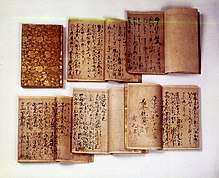Senju-ji
Senju-ji (専修寺), also known as Takadayama (高田山), refers to a pair of temples which are the chief Buddhist temples of the Takada branch of Jōdo Shinshū, a Japanese Buddhist sect. The current head temple, Senju-ji Honzan, founded in the 15th century, is located in Mie Prefecture. The original head temple, Senju-ji Hon-ji, founded in 1225, is located in Tochigi Prefecture. Both temples are governed by the same abbot.
Senju-ji Hon-ji
| Hon-ji Senju-ji 本寺専修寺 | |
|---|---|
 | |
| Religion | |
| Affiliation | Jōdo Shinshū Takada-ha |
| Location | |
| Location | Takada, Ninomiya-machi, Haga-gun, Tochigi prefecture |
| Country | Japan |
| Geographic coordinates | 36°23′38″N 140°01′23″E |
| Architecture | |
| Completed | 1225 |
| Website | |
| www.honji-senjuji.jp/ | |
Senju-ji Hon-ji was founded by Shinran in 1225. According to legend, a child appeared to Shinran and presented him with seeds and a staff, which he planted in this place to establish the temple.[1] A modern theory is that the origin of Senju-ji was an existing temple where Shinran resided and preached after returning to Eastern Japan from exile in Echigo.[2]
Soon after its founding, Senju-ji was named an imperial temple (chokuganji) and Shinran made it the center of his activities. He resided here for seven years before returning to Kyoto, and his followers made it an important center of Shinshū Buddhism in Eastern Japan. But much of the temple was destroyed during the civil wars of the 15th century, and leadership of the Takada branch gradually shifted to the Honzan temple in Tsu.[1]
The temple's current building dates mainly from an Edo-period reconstruction. Some have been declared Important Cultural Properties by the prefecture and national government.
Senju-ji Honzan
| Honzan Senju-ji 本山専修寺 | |
|---|---|
Nyorai-dō | |
| Religion | |
| Affiliation | Jōdo Shinshū Takada-ha |
| Status | Head temple |
| Location | |
| Location | 2819 Ishinden-chō, Tsu, Mie Prefecture |
| Country | Japan |
| Geographic coordinates | 34°45′44″N 136°30′13″E |
| Architecture | |
| Founder | Shin'ne |
| Completed | 1469–1487 |
| Website | |
| www.senjuji.or.jp/ | |
The Senju-ji in Tsu is traditionally said to have been founded by the monk Shinne, who had arrived from Takada.[3] Its predecessor may have been a temple named Muryōju-ji, which came to be called Senju-ji Honzan in the late 16th century.[2] Historically it was closely related to the imperial court and aristocratic culture. In 1478 it was designated an imperial temple, and in 1574 it became a monzeki.
Buildings include the Mieidō (1666) and Nyoraidō (1748), both of which escaped fires in the 18th century and have been designated National Treasures.

Important cultural properties preserved at the temple include paintings, statues, and documents.[4] The Notes on Guidance Toward Birth in the West (西方指南抄, saihō shinanshō) is a compilation in six volumes of the words, teachings, and practices of Shinran's teacher Hōnen. According to the colophons, Shinran wrote it at the age of 84. It is the oldest primary source of its kind and the best attested of Shinran's late writings in his own hand.[5] It was designated a National Treasure in 1953.
See also
- List of National Treasures of Japan (writings: others)
- For an explanation of terms concerning Japanese Buddhism, Japanese Buddhist art, and Japanese Buddhist temple architecture, see the Glossary of Japanese Buddhism.
Notes
- "親鸞聖人と専修寺" [Shinran and Senju-ji] (in Japanese). Senju-ji Hon-ji. Retrieved 9 December 2017.
- Mōri, Ichirō. "専修寺-信仰と歴史と文化" [Senju-ji – Belief, Culture and History] (in Japanese). Mie Prefectural Art Museum. Retrieved 9 December 2017.
- "高田本山 専修寺の歩み" [Takada Honzan Senju-ji Timeline] (in Japanese). Senju-ji Honzan. Retrieved 9 December 2017.
- "宝物のご紹介" [Description of temple treasures] (in Japanese). Senju-ji Honzan. Retrieved 9 December 2017.
- 西方指南抄 [Notes on Guidance Toward Birth in the West] (in Japanese). Mie Prefecture. Archived from the original on 2011-07-22.
References
- Frederic, Louis (2002). "Japan Encyclopedia." Cambridge, Massachusetts: Harvard University Press.
External links
![]()
![]()